Thermoisolating and Colour Systems
THERMAL CORRECTION OF A BUILDING
To achieve all the objectives indicated by the DI6/26/15 "Minimum requirements"which indicates the minimum thermal performance values of buildings, great attention must be paid to making the right technical choices and using the right materials to obtain ideal thermal insulation. The achievement of good thermal insulation is the essential element to obtain an excellent level of living comfort and consequent economic savings for the management of winter heating and summer cooling.
Matching COAT plasters
To adequately insulate the walls and achieve effective thermal insulation, it is possible to use thermal insulating plasters with high breathability and with considerable ease of application. packaging and laying procedures are the Same as traditional plasters, but containing light aggregates with particular characteristics and natural additives that facilitate their installation and guarantee a correct adhesion on any type of masonry even with thicker layers, greater than the usual stratigraphy, controlling shrinkage and guaranteeing a slow and optimal maturation. Thanks to the ease of modelling of the fresh plaster, it is possible to create all the details and to follow the shapes of cavities and/or roughness of the masonry surfaces to be covered, with the creation of a uniform covering of masonry surfaces. A thermal insulation operation with thermal insulating plaster is preferableto coatings with plastic sheets (EPS, XPS, etc.), as the latter requires specialised labor and creates a barrier to the natural passage of water vapor through the wall. There is another aspect to consider, namely heating by direct APBI.
Often we think only of the winter and summer thermal insulation, creating a coat with plastic materials with high thermal performances. While this solution is excellent for winter and summer environmental insulation, thanks to the low conductivity of the material, it neglects thermal inertia. This is not possessed by these materials and ignores the delay of at least 8/10 Hours before thermal transmission occurs. This guarantees the non-heating of the interior, with considerable discomfort for the occupants. In fact, the use of matching thermal insulating plaster allows, thanks to a mass considerably higher than that of plastic materials (300/400kg/MC against 10/20kg/MC), to provide an increase in the total thermal inertia of the wall, therefore greater isolation with regard to direct radiation. Do not forget the insulation of the walls towards unheated rooms where the regulation imposes a transmittance value U ≤ 0, 80w/M2K that can be achieved with the application of only 2 cm on both sides of our thermal insulating plasters on a wall in 12 cm perforated blocks , and only 1.5 cm on both sides of our thermal insulating plaster on a wall in 20 cm perforated blocks.
BUILDING SYSTEMS AND HOUSING COMFORT
Malvin has worked in this regard through the experimentation and implementation of innovative and specific building systems for solving these problems. It offers a new range of products, born from studies and experiments in our RESEARCH and DEVELOPMENT WORKSHOPS and from direct experience on site, for the creation of thermal insulating plasters not only of high quality and durability but also of easy and fast Application. For the achievement of the best living comfort and respect for the values by the regulations governing thermal insulation of 26/06/15 "Minimum requirements" the "THERMO-insulation and COLOR PLASTER SYSTEM" provides a series of innovative, Safe and durable construction solutions.

Intosughero
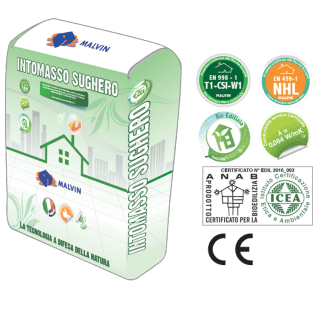
Eco-friendly, lightened, fibro-reinforced Bio-plaster with a special composition of specially designed polypropylene fibres. based on natural raw materials such as gcork and natural hydraulic lime according to EN 459-1 for Certified, sound absorbing and dehumidifiers and/or thermal protection on beams and pillars in reinforced concrete, inside and outside with mechanical and manual application. Use as Finuture intocalce FLEX or Intocalce MAX. The characteristics of the natural hydraulic lime in NHL are such as to guarantee a very slow and constant hardening that allows to obtain plasters with high durability and breathability. It does not form barriers to steam and does not contain solvents. Recyclable as inert at the end of life.
Packaging: 50 lt sacks-55 sacks Footboards
Usage: Indoor/outdoor
Color: Hazelnut
Particle size: ≤ 3 mm Yield: 1 bag per 1 sq m thickness 4 cm
Vapour flow resistance coefficient en 1015-19: μ ≤ 5 capillary water absorption en 1015-18: Class "W1"
Specific Heat EN 1745:00 kj/kg K
Certified Thermal conductivity: λ = 0.064 W/MK *
Specific weight dry mortar: 400 Kg/MC *
Certification: Certificate Institute LAPI S.p.A. N ° 347.2 DC 0050/12
Intotherm
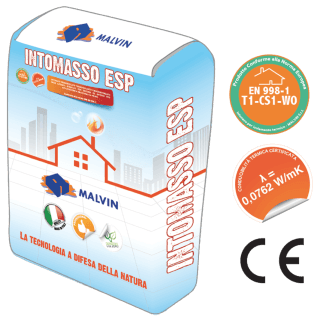
Lightened pre-mixed fiber-reinforced plaster, with a special composition of specially designed polypropylene fibers, water-repellent, based on hydraulic binders, expanded polystyrene beads and lightweight mineral inerts with very high thermal insulation, for the realization of internal thermal insulation coatings and external and / or thermal protection on reinforced concrete beams and pillars, for mechanical and manual application. Use as finishing INTOFIN FLEX or INTORAS FLEX. It does not form vapor barriers and does not contain solvents.
PACKAGING: 50 Lt bags - 55 bags sacks
USE: Indoor / Outdoor
Color: Grey
GRANULOMETRY: ≤ 5 mm YIELD: 1 bag per 1 m2, 4 cm thick
EN 1015-19 STEAM PASSAGE RESISTANCE COEFFICIENT: μ = 9 CAPILLARY WATER ABSORPTION EN 1015-18: Class "W1"
CERTIFIED THERMAL CONDUCTIVITY: λ = 0.07 W / mK *
SPECIFIC WEIGHT OF DRY MALTA: 350Kg / mc *
CERTIFICATION: Polytechnic Certificate of Bari No. 93/870
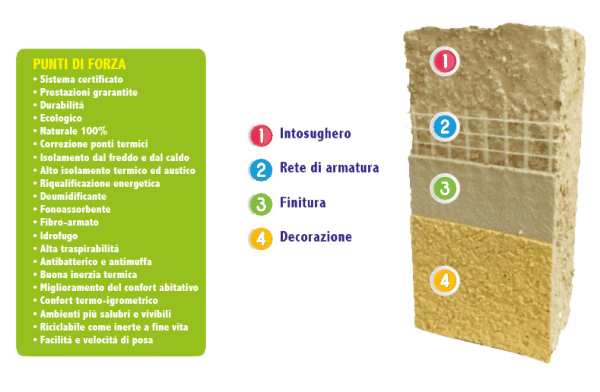
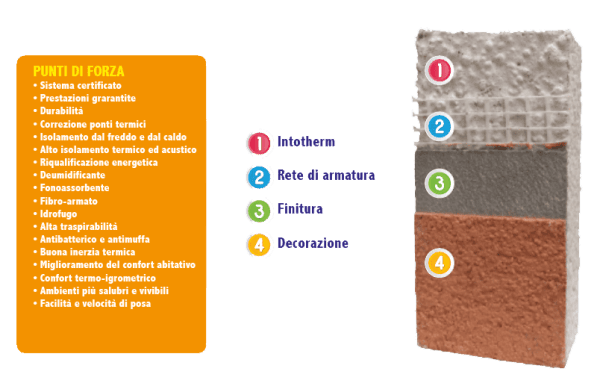
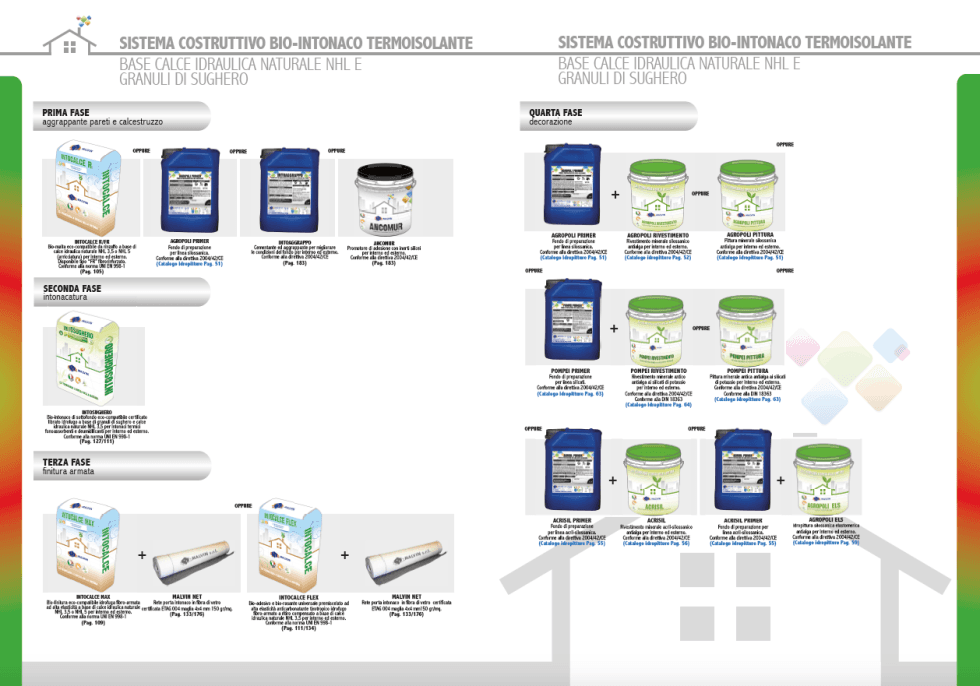
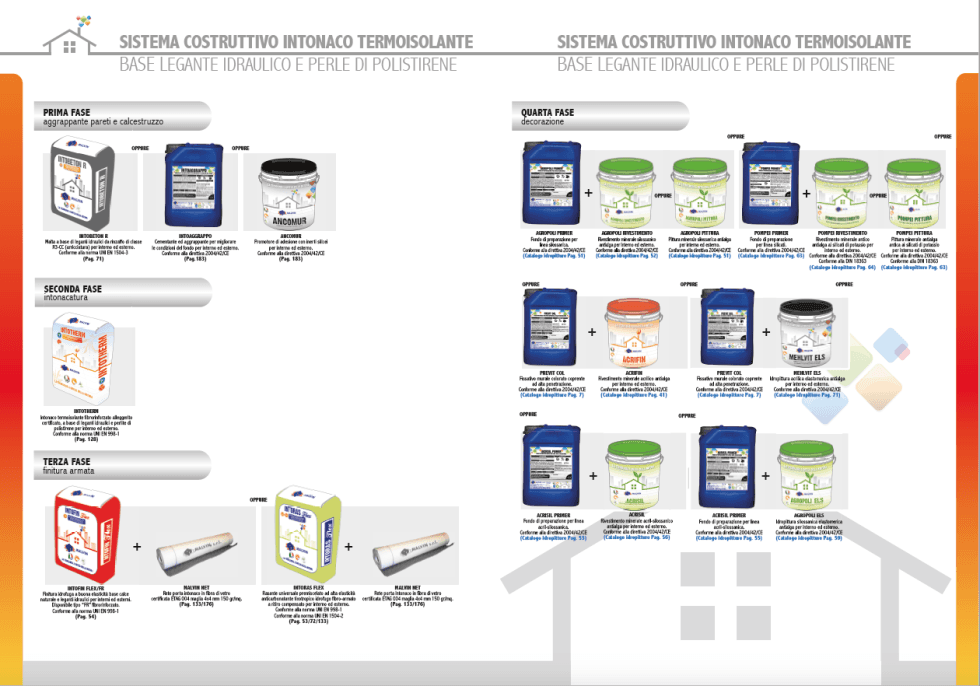
INTOSUGHERO system on walls in blocks
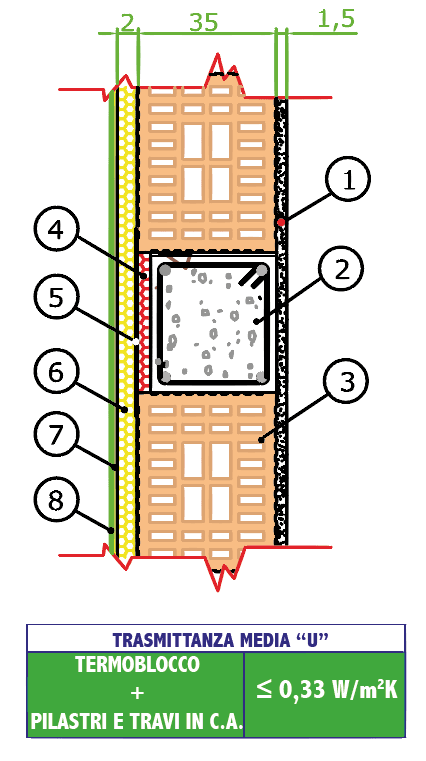
1
Internal plaster
2
AC pillar 30 cm thick
3
Thermoblock in brick thickness 35 cm with thermal conductivity
equivalent λ = 0.11 W / mK
4 INTOSUGHERO thickness 5 cm
5
FIBERGLASS plaster mesh mesh 1x1 cm
6
INTOSUGHERO thickness 2 cm
7
finish with ETIB 004 certified FIBERGLASS plaster mesh 5 x 5 mm mesh 160 g / m2
8
Decoration
INTOTHERM system on walls in blocks
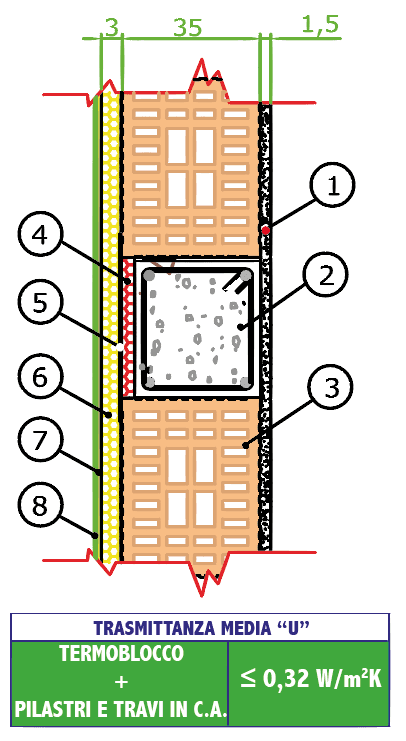
1
internal plaster
2
pillar in reinforced concrete 30 cm thick
3
Thermoblock in brick thickness 35 cm with thermal conductivity
equivalent λ = 0.11 W/MK
4
intotherm Thickness 5 cm
5
Fibreglass Mesh 1x1 cm
6
Intotherm thickness 3 cm
7
finishing with a fibreglass holder with an ETAG-certified glass mesh 004 5x5 mm from 160 gr/MQ
8
Decoration
WALLS IN BLOCKS
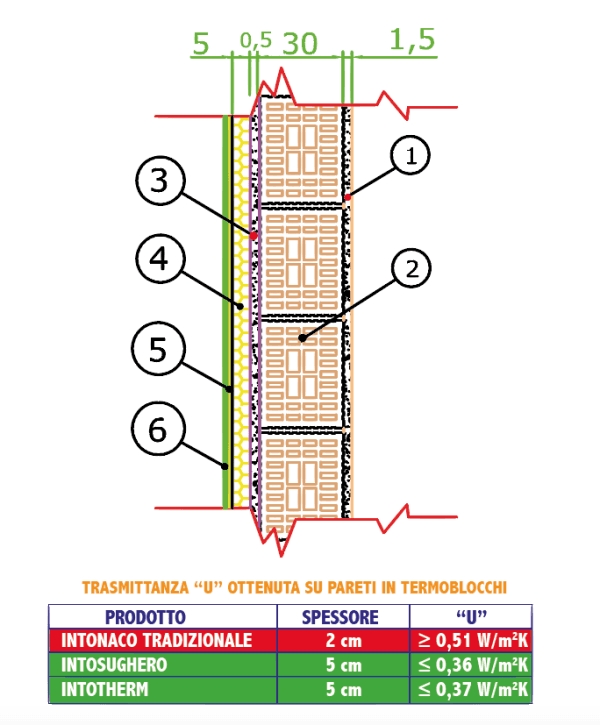
1
internal plaster
2
Thermoblock in brick thickness
30 cm with equivalent thermal conductivity λ = 0.17 W/MK
3
Rinzaffo Thickness 0.5 cm
4
Intotherm-Thickness 5 cm
5
finishing with a fibreglass holder with an ETAG-certified glass mesh 004 5x5 mm from 160 gr/MQ
6
Decoration
INTOTHERM system on walls in blocks
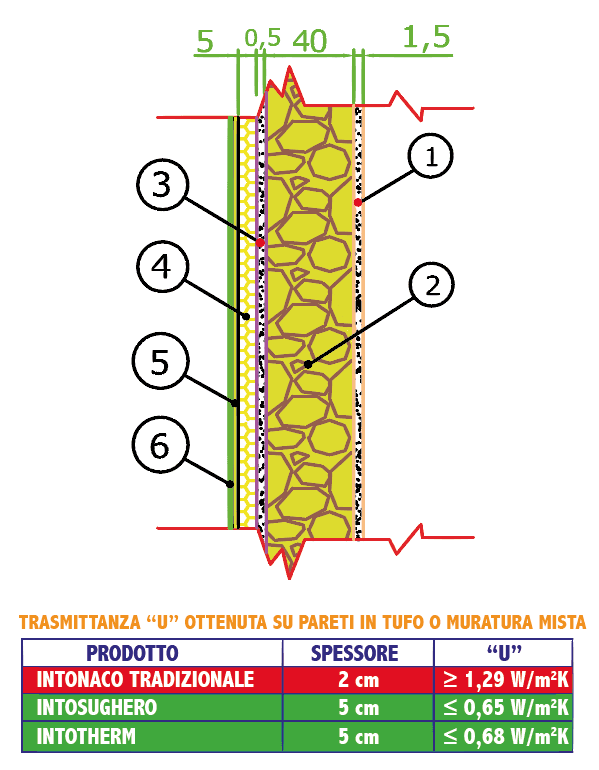
1 Internal plaster
2 Wall in tuff or mixed wall thickness 40 cm with thermal conductivity equivalent λ = 0.70 W / mK
3 0.5 cm thick scratch coat
4 INTOSUGHERO OR INTOTHERM thickness 5 cm
5 finish with ETIB 004 certified FIBERGLASS plaster mesh 5 x 5 mm mesh 160 g / m2
6 Decoration









